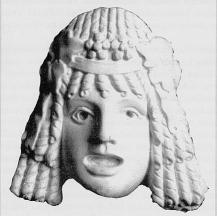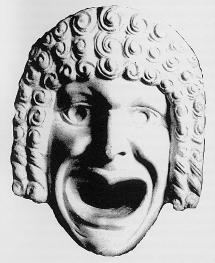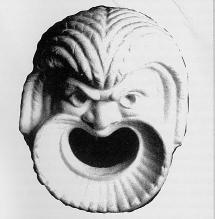back to "The Story of the Mask"
|
back to "The Story of the Mask" |
Face
Together with speech and gestures, facial expressions are manís main natural
and original means of communication. Facial expressions highlight, conceal or,
depending on the occasion, mislead messages conveyed by speech and gestures. When people deliberately hide their faces from outsiders, they experience something
fascinating and ambiguous, something which is extremely difficult to describe
clearly and comprehensibly. At the same time such an experience may be both
emancipating and frightening, strangely fascinating and oppressive. At any rate,
the experience is associated with a Feeling of power, a feeling which can be
described as originating from the knowledge that controls the message and avoids
unintentional and revealing expressions which would enable more to be read into
a message than intended.
When people deliberately hide their faces from outsiders, they experience something
fascinating and ambiguous, something which is extremely difficult to describe
clearly and comprehensibly. At the same time such an experience may be both
emancipating and frightening, strangely fascinating and oppressive. At any rate,
the experience is associated with a Feeling of power, a feeling which can be
described as originating from the knowledge that controls the message and avoids
unintentional and revealing expressions which would enable more to be read into
a message than intended.
 The face may also be concealed as a means of protection
from external conditions. In the latter case, this may also relate to earlier
feelings and experiences introduced. On the one hand, concealing the face is
masquerading and at the same time a traditional way of hiding, of retaining
anonymity. On the other hand, it is an effective means of conveying unambiguous
matters to the outside world. A mask itself may be both a physical object worn
over the face or a material or expression behind which you conceal that which
you do not want those present to notice. The belief that a person is what he
appears does not just give mask wearers a new anonymous face, it also gives
them a new personality. From an outsiderís point of view, the loss of personality
originally connected to wearing a mask is perhaps
more important as an
object of anonymity than from the perspective of the wearer himself. A mask
also provides an inverse opportunity to reveal the real ego, free from the bonds
of social norms and rules of behavior and the everyday mask.
The face may also be concealed as a means of protection
from external conditions. In the latter case, this may also relate to earlier
feelings and experiences introduced. On the one hand, concealing the face is
masquerading and at the same time a traditional way of hiding, of retaining
anonymity. On the other hand, it is an effective means of conveying unambiguous
matters to the outside world. A mask itself may be both a physical object worn
over the face or a material or expression behind which you conceal that which
you do not want those present to notice. The belief that a person is what he
appears does not just give mask wearers a new anonymous face, it also gives
them a new personality. From an outsiderís point of view, the loss of personality
originally connected to wearing a mask is perhaps
more important as an
object of anonymity than from the perspective of the wearer himself. A mask
also provides an inverse opportunity to reveal the real ego, free from the bonds
of social norms and rules of behavior and the everyday mask.
Mask
Throughout history masks have been made of all possible, and impossible, types
of material such as wood, metal, stone, straw, reed, leather, bone, horn, feathers,
paper, etc. Masks have been made from virtually every material imaginable which
can be worked by hand or tool. Mask use, the materials and tools available,
and the prevailing traditions have dictated the choice of material. Even in
this modem age of artificial fibres, the working methods and application of
materials developed over thousands of years are still used when making masks.
Masks have played an essential part in prehistoric maní s various rituals
connected with cults, hunting, story telling, conveying messages and confirming
tribal identity. A mask has also served to highlight its wearerís position in
the social hierarchy. The habit of wearing masks on different occasions may
originally have arisen quite simply from a need to protect against the affect of
the climate, the sun or from a desire to scare enemies.
All in all the saying that a mask has
two sides is an extremely clear description of the ambiguity of the topic. On
the one hand, concealment, protection and its importance, on the other,
communication and revealment. A mask usually makes it possible to simplify and
clarify an expression or message, and above all gets the message across more
effectively. A soldierís helmet was more than just a protection device. It
also had an equally important function, that of conveying its wearerís bravery
and power to the enemy. In other words it functioned just like a mask.
Throughout history wearing a mask has
taken on many various forms which often seem to have little connection with
ancient rituals. Deep down, however, the issue stems from the same need to
protect. In the end this need manifests itself as masquerading or wearing a mask
on different occasions. Death masks were used in many cultures before the
beginning of our chronology, both in the old and new continents. Among other
things, the ancient Egyptians were in the habit of dressing persons of noble
birth in splendid masks before burial. These masks preserved and protected the
deceased from impending dangers on their journey to the kingdom of the dead.
Masks also played an important role in national festivities such as carnivals,
which where often linked to religious rituals performed at certain times of the
year. It is impossible whit any degree of accuracy to ascertain when ancient
rituals and cult ceremonies changed, or when carnivals, theatre and other
situations and events requiring the use of masks to dispel everyday reality and
uplift the spirit, developed alongside them. The aforementioned enabled a
society's strict social hierarchy to lapse for a fixed period and gave room for
critical laughter and fun at the expense of those in power, thus functioning as
a kind of social safety valve.
 One reason for the maskís popularity, especially in theatre, can be that the
public prefers to see well-known popular actors playing their familiar successful
roles than experience a novel aspect by an unknown performer which takes time
and effort to get accustomed to. In this sense, the mask represents a lasting,
successfully proven tradition which, at the same time, as if guarantees quality,
thus sparing the public from disappointment.
One reason for the maskís popularity, especially in theatre, can be that the
public prefers to see well-known popular actors playing their familiar successful
roles than experience a novel aspect by an unknown performer which takes time
and effort to get accustomed to. In this sense, the mask represents a lasting,
successfully proven tradition which, at the same time, as if guarantees quality,
thus sparing the public from disappointment.